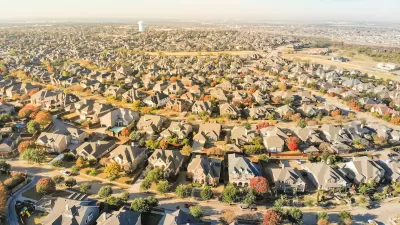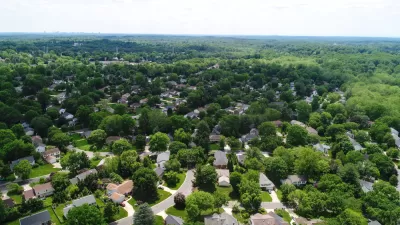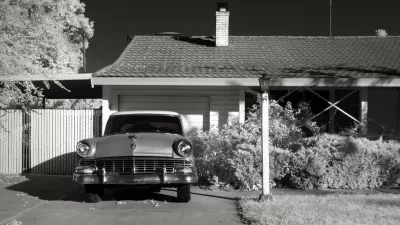In Order Without Design, Alain Bertaud takes a middle position between consistent supporters of suburbia and sprawl critics.

In his new book, Order Without Design, planner Alain Bertaud tries to apply the insights of urban economics to the world’s megacities. He begins with a simple assumption: that the major economic advantage of large cities is that more people can find suitable employers and employees than in smaller places, and that this advantage is reaped "only if workers, consumers and suppliers are able to exchange labor, goods and ideas with minimum friction and to multiply face-to-face contacts with minimum time commitments and cost" (p. 28). He therefore reasons that urban planners must have two primary goals: affordability (so that workers can afford to commute to jobs in cities) and mobility (so that workers can reach those jobs quickly).
Because of his emphasis on affordability, Bertaud generally favors minimal government regulation of housing markets in both cities and suburbs. He properly writes that "all binding regulations increase the cost of housing…[by requiring] builders to use more land than the market would require" (p. 303). Bertaud adds that one reason for density regulation is to prevent 19th-century levels of discomfort. But these standards set a minimum cost that is above what some households can pay; as a result, these low-income households must either live in illegal apartments or be homeless. Moreover, such government regulations are often outdated. Even in dense New York City, today’s tenements are far more comfortable than they were a century ago, because they generally now have kitchens, bathrooms, and air conditioning.
Bertaud also criticizes height limits, because they reduce the supply of land available for housing. For example, he notes that because Paris aggressively restricts height in the city’s historic areas, it has created such a shortage of urban floor space that a studio apartment in Paris costs nine times as much per square meter as a one-bedroom apartment in downtown Chicago. One common rationale for height limits is that they reduce the available supply of sunlight; Bertaud responds that because today's apartments have ample electricity, most apartment-dwellers need less outdoor sunlight than they did a century or two ago.
Bertaud is not as aggressive as I would have liked, however, in confronting anti-supply counterarguments. For example, he does not directly address claims that certain types of new housing might lead to increased land costs or gentrification.
One alternative to less regulation is for government to build or subsidize housing—but as Bertaud points out, this policy is rarely successful because of its expense to government. For example, he notes that in New York City, far more households are on a waiting list for vouchers than actually receive such vouchers. Inclusionary zoning (that is, setting aside X percent of market-rate apartments for low-cost units) similarly creates very few beneficiaries unless government allows a huge number of market-rate units. Public housing is more expensive for taxpayers than other options, and locks poor households into a site chosen by government. Bertaud does not deny that the truly destitute will need public housing. However, he writes that if housing markets are allowed to function properly, this number will be low.
Bertaud also opposes anti-sprawl regulations such as growth boundaries, and further suggests that governments should supply infrastructure to new suburbs. He reasons that any policy that increases the supply of developable land increases affordability.* In fact, Bertaud treats some degree of sprawl as inevitable, noting that urban densities have decreased over the past century due to improved transportation technology. This argument seems to be to a bit incomplete, since government has the choice to subsidize or not to subsidize such technology. In a city where government follows Bertaud's advice and spends lots of money on roads or suburban transit, a city's suburbs are likely to expand more rapidly than in a city with a more parsimonious government.
Unlike some defenders of sprawl, Bertaud does not purport to be a small-government conservative or libertarian. Because he believes that markets work most efficiently with high levels of mobility (i.e., speedy commutes), he seems to favor ample government spending on both roads and public transit. While some planning scholars dream of more compact cities, Bertaud writes that workers benefit most when "they could look for jobs as well as cultural and commercial amenities throughout an entire metropolitan area" (p. 146).
Bertaud differs from more anti-urban commentators in two other respects. First, some commentators argue that the rise of the Internet has made distance irrelevant; Bertaud quite properly throws this claim into the rubbish bin, pointing out that if distance was irrelevant, urban cores would have lost value in the 21st century, instead of gaining value. He adds that high "real estate prices demonstrate that even in cities where mobility causes severe friction [such as New York] being physically close to a large concentration of people, jobs and amenities is still worth a very high price" (p. 152). It seems to me, however, that the value of congested places shows that transportation planners’ obsession with mobility and congestion somewhat misses the point: congested places nevertheless manage to prosper.
Second, Bertaud admits that government provides more sprawl than is economically or environmentally efficient, writing that "users of urban roads seldom pay market rents for the road area they occupy while commuting" (p. 100) and that this subsidy increases suburbanization. And because car users do not pay for the "pollution, congestion and other costs they have imposed on others" (p. 159). Bertaud accordingly supports pricing of roads through tolls (Id.). He also suggests that on-street parking should be more expensive, to pay for the congestion caused by such parking. Similarly, he writes that because of the difficulty of pricing pollution and greenhouse gas emissions, "governments should set pollution and GHG emission targets as a substitute for price" (p. 217).
But the transportation policies that Bertaud supports makes these solutions politically impractical. When government facilitates auto-dependent sprawl, it creates a large constituency of voters dependent on cars to commute. These voters, and the companies that sell them cars and gasoline, are likely to resist any attempt to make car commuting more expensive, such as toll roads, increased parking fees, or pollution controls that make driving more costly. Thus, the United States is caught in a vicious circle: road expansion creates suburban growth, creating a political constituency that blocks attempts to limit the externalities caused by car travel, causing even more car travel and suburban growth. Even if traditional anti-sprawl policies are not as efficient as removing pro-sprawl market distortions, they may be a viable second-best solution if tolls and similar remedies are politically impractical.
Moreover, Bertaud is, it seems to me, unduly optimistic about the ability of regulation to limit emissions. The rise of sport utility vehicles has slowed improvements in fuel economy to a crawl, and it seems unlikely that this situation will change.
Bertaud is not anti-transit: he suggests that local governments should "favor and facilitate a large mix of transport modes" (p. 216), especially in dense cities like New York and Paris. One of Bertaud’s more visionary suggestions is that subways should have fewer stations and run at high speeds; for example, he writes that subways and commuter trains should be 10 kilometers (6.2 miles) apart and run 150 kilometers (93 miles) per hour, so that commuters could cross an entire region in one hour. Of course, this idea would make it impossible for most commuters to walk to train stations, and would radically increase bus and/or auto traffic to those stations. So I question whether this vision would actually facilitate commuting. It seems to me that if driving became more expensive and transit became less convenient, the resulting inconvenience might well outweigh the increased speed of trains.
In sum, Bertaud generally considers suburban expansion to be useful—less because of a belief in free-market orthodoxy than because he believes it facilitates affordable, fast commuting. However, his support for pro-suburban policies is less rigid than that of other commentators, such as Joel Kotkin. He acknowledges that vehicle-dependent sprawl has negative environmental consequences, although he is more optimistic than I am that better regulation could limit those consequences.
*Of course, this argument is less persuasive in cheap cities such as Buffalo or St. Louis. However, most of Bertaud’s work has been in growing cities, and he admits that the "problems encountered by cities with declining populations are very different from the ones described [in most of his book]" (p. 377).

Maui's Vacation Rental Debate Turns Ugly
Verbal attacks, misinformation campaigns and fistfights plague a high-stakes debate to convert thousands of vacation rentals into long-term housing.

Planetizen Federal Action Tracker
A weekly monitor of how Trump’s orders and actions are impacting planners and planning in America.

In Urban Planning, AI Prompting Could be the New Design Thinking
Creativity has long been key to great urban design. What if we see AI as our new creative partner?

King County Supportive Housing Program Offers Hope for Unhoused Residents
The county is taking a ‘Housing First’ approach that prioritizes getting people into housing, then offering wraparound supportive services.

Researchers Use AI to Get Clearer Picture of US Housing
Analysts are using artificial intelligence to supercharge their research by allowing them to comb through data faster. Though these AI tools can be error prone, they save time and housing researchers are optimistic about the future.

Making Shared Micromobility More Inclusive
Cities and shared mobility system operators can do more to include people with disabilities in planning and operations, per a new report.
Urban Design for Planners 1: Software Tools
This six-course series explores essential urban design concepts using open source software and equips planners with the tools they need to participate fully in the urban design process.
Planning for Universal Design
Learn the tools for implementing Universal Design in planning regulations.
planning NEXT
Appalachian Highlands Housing Partners
Mpact (founded as Rail~Volution)
City of Camden Redevelopment Agency
City of Astoria
City of Portland
City of Laramie






























